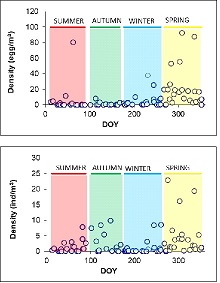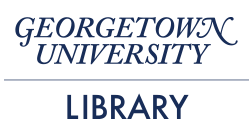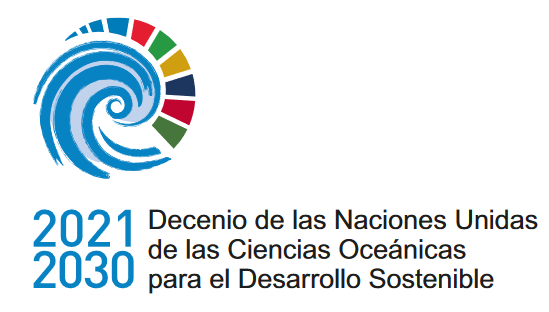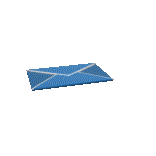Etapas tempranas de la anchoíta: abundancia, variabilidad y condición larval en la estación fija EPEA entre 2000-2017
DOI:
https://doi.org/10.47193/mafis.3422021010601Palabras clave:
Engraulis anchoita, ictioplancton, condición nutricional, estacionalidad, series de tiempoResumen
Se analizaron las densidades de huevos y larvas de Engraulis anchoita y el estado nutricional de las larvas en la estación de muestreo fija (EPEA) en el período 2000-2017. Estas variables se analizaron estacionalmente y se determinaron las tendencias en el tiempo. Las muestras de ictioplancton se recolectaron mediante arrastres oblicuos utilizando redes Bongo con 300 μm de poro de malla y se fijaron con formaldehído al 5% en agua de mar. Se midieron seis variables morfométricas para estimar el estado nutricional de las larvas. También se determinó la etapa de desarrollo de cada espécimen. El mayor valor medio de densidad de huevos se detectó en el período octubre-diciembre, con una moda secundaria en agosto, seguida de otra en marzo. La densidad larvaria presentó una moda en octubre. El otoño y la primavera fueron las estaciones más favorables para la condición larvaria, mientras que el invierno resultó ser la menos favorable. Un aumento en la disponibilidad de alimentos durante el otoño y la primavera debido a los picos de producción primaria y secundaria podría explicar el alto estado nutricional y los valores de crecimiento observados en estas temporadas en la EPEA. No se detectaron cambios en las tendencias de las variables a lo largo del tiempo. El estudio integrado de densidad y condición nutricional de larvas de E. anchoita permite determinar períodos de cría favorables para la especie, mientras que la continuación del estudio a largo plazo permitirá evaluar posibles efectos del cambio climático en las primeras etapas de vida de esta especie.
Descargas
Referencias
Angelescu V. 1982. Ecología trófica de la anchoíta del Mar Argentino (Engraulidae, Engraulis anchoita). Parte II. Alimentación, comportamiento y relaciones tróficas en el ecosistema. Contrib Inst Nac Invest Desarr Pesq (Mar del Plata). Nº 409. 83 p.
Auad G, Martos P. 2012. Climate variabilityof the Northern Argentinean Shelf Circulation: impact on Engraulis anchoita. Int J Ocean Climate Syst. 3 (1): 17-43. DOI: https://doi.org/10.1260/1759-3131.3.1.17
Bakun A. 2006. Wasp-waist populations and marine ecosystem dynamics: navigating the “predator pit” topographies. Prog Oceanogr. 68: 271-288.
Beaugrand G, Brander KM, Lindley JA, Souissi S, Reid PC. 2003. Plankton effect on cod recruitment in the North Sea. Nature. 426: 661-664.
Brewer GD. 1976. Thermal tolerance and resistence of the northern anchovy Engraulis mordax. Fish Bull US. 74: 1- 8.
Castro LR, Salinas GR, Hernández EH. 2000. Environmental influences on winter spawning of the anchoveta Engraulis ringens off Central Chile. Mar Ecol Prog Ser. 197: 247-258.
Ciechomski JD. 1967a. Present state of the investigations on the Argentine Anchovy Engraulis anchoita (Hubbs, Marini). Cal Coop Ocean Fish. 11: 58-66.
Ciechomski JD. 1967b. Influence of some environmental factors upon the embryonic development of the Argentine anchovy Engraulis anchoita. Cal Coop Ocean Fish. 11: 67-71.
Ciechomski JD. 1969. Investigaciones sobre la distribución de huevos de anchoíta frente a las costas argentinas, uruguayas y sur del Brasil; resultados de nueve campañas oceanográficas, agosto 1967-julio 1968. FAO Proy Desarr Pesq. Ser Inf Téc. 14: 1-10.
Ciechomski JD, Booman CI. 1983. Distribución cuantitativa de huevos y larvas de anchoíta (Engraulis anchoita) en la plataforma continental, frente a las costas de la Argentina y Uruguay en el ciclo anual 1981/1982. Contrib Inst Nac Invest Desarr Pesq (Mar del Plata). Nº 431. 14 p.
Ciechomski JD, Ehrlich MD, Lasta CA, Sánchez RP. 1981. Distribución de huevos y larvas de peces en el Mar Argentino y evaluación de los efectivos de desovantes de anchoíta y de merluza. Contrib Inst Nac Invest Desarr Pesq (Mar del Plata). Nº 383. 20 p.
Ciechomski JD, Sánchez RP. 1984. Field estimates of embryonic mortality of Southwest Atlantic anchovy (Engraulis anchoita). Meeresforschung. 30: 172-187.
Ciechomski JD, Sánchez RP. 1988. Análisis comparativo de las estimaciones de biomasa de la anchoíta (Engraulis anchoita) en el Atlántico Sudoccidental en diferentes años y con distintas metodologías. Publ Com Téc Mix Fr Mar. 4. 14 p.
Cunha I, Saborido-Rey F, Planas M. 2003. Use of multivariate analysis to assess the nutritional condition of fish larvae from nucleic acids and protein content. The Biol Bull. 204: 339-349.
Cushing DH. 1969.The regularity of the spawning season of some fishes. J Cons Int Explor Mer. 33: 81-92.
Cushing DH. 1990. Plankton production and year-class strength in fish populations: an update of the match/mismatch hypothesis. In: Blaxter JHS, Southward AJ, editors. Advances in marine biology. San Diego: Academic Press Limited. p. 250-313.
Diaz MV. 2010. Análisis espacio-temporal del estado nutricional de larvas de anchoíta Engraulis anchoita. Relación con las características hidrográficas y la disponibilidad de alimento [PhD thesis]. Buenos Aires: Facultad de Ciencias Exactas y Naturales, Universidad de Buenos Aires. 282 p.
Diaz MV, Pájaro M, Sánchez RP. 2009. Employment of morphometric variables to assess nutritional condition of Argentine anchovy larvae Engraulis anchoita Hubbs & Marini, 1935. Rev Biol Mar Oceanog. 44: 539-549.
Do Souto M, Brown DR, Leonarduzzi E, Capitanio F, Diaz MV. 2019. Nutritional condition and otolith growth of Engraulis anchoita larvae: the comparison of two life traits indexes. J Marine Syst. 193: 94-102.
Edwards M, Richardson AJ. 2004. Impact of climatic change on marine pelagic phenology and trophic mismatch. Nature. 430: 881-884.
Ferron A, Leggett WC. 1994. An appraisal of condition measures for marine fish larvae. Adv Mar Biol. 30: 217-303.
Govoni JJ. 2005. Fisheries oceanography and the ecology of early life histories of fishes: a perspective over fifty years. Sci Mar. 69: 125-137.
Hansen JE. 2004. Anchoíta (Engraulis anchoita). In: Sánchez RP, Bezzi SI, editors. El Mar Argentino y sus recursos pesqueros. Tomo 4. Los peces marinos de interés pesqueros. Caracterización biológica y evaluación del estado de explotación. Mar del Plata: Instituto Nacional de Investigación y Desarrollo Pesquero (INIDEP). p. 101-115.
Hernández RD, Mendiolar M. 2018. Programa csmk, Implementación de un test no paramétrico para datos estacionales con dependencia serial y datos faltantes. Inf Ases Transf INIDEP Nֻº 143/2018: 1-13.
Hirsch RM, Slack JR. 1984. A nonparametric trend test for seasonal data with serial dependence. Water Resour. Res. 20: 727-732.
Hjort J. 1914. Fluctuations in the great fisheries of northern Europe viewed in the light of biological research. Rapp P-V Reun Cons int Explor Mer. 20: 1-228.
Leonarduzzi E, Brown DR, Sánchez R. 2010. Seasonal variations in the growth of anchovy larvae (Engraulis anchoita) on the Argentine coastal shelf. Sci Mar. 74: 267-274.
Lleonart J, Salat J, Torres GJ. 2000. Removing allometric effects of body size in morphological analysis. J Theor Biol. 205: 85-93.
Lucas AJ, Guerrero RA, Mianzan HW, Acha EM, Lasta CA. 2005. Coastal oceanographic regimes of the Northern Argentine Continental Shelf (34-43°S). Estuar Coast Shelf Sci. 65: 405-420.
Mackas DL, Thomson RE, Galbraith M. 2001. Changes in the zooplankton community of the British Columbia continental margin, 1985-1999, and their covariation with oceanographic conditions. Can J Fish Aquat Sci. 58: 685-702.
Madureira LASP, Castello JP, Hernandez CP, Queiroz MI, Espírito Santo MLP, Ruiz WA, Abdallah PR, Hansen JE, Bertolotti MI, Manca EA, et al. 2009. Current and potential alternative food uses of the Argentine anchoita (Engraulis anchoita) in Argentina, Uruguay and Brazil. In: Hasan MR, Halwart M, editors. Fish as feed inputs for aquaculture: practices, sustainability and implications. Rome: FAO. p. 269-287.
Malavolti S, De Felice A, Costantini I, Biagiotti I, Canduci G, Grilli F, Marini M, Tirelli V, Borme D, Caputo Barucchi V, Leonori I. 2018. Distribution of Engraulis encrasicolus eggs and larvae in relation to coastal oceanographic conditions (a south-western Adriatic Sea case study). Medit Mar Sci. 19: 180-192.
Martos P, Hansen JE, Negri RM, Madirolas A. 2005. Factores oceanográficos relacionados con la abundancia relativa de anchoíta sobre la plataforma bonaerense (34° S-41° S) durante la primavera. Rev Invest Desarr Pesq. 17: 5-33.
Matsuura Y, Kitahara EM. 1995. Horizontal and vertical distribution of anchovy Engraulis anchoita eggs and larvae off Cape Santa Marta Grande in southern Brazil. Arch Fish Mar Res. 42: 239-250.
Matsuura Y, Spach HL, Katsuragawa M. 1992. Comparsion of spawning patterns of the Brazilian sardine (Sardinella brasiliensis) and anchoita (Engraulis anchoita) in Ubatuba region, southern Brazil during 1985 through 1988. Bolm Inst Oceanogr USP. 40: 101-115.
McGurk MD. 1985. Multivariate analysis of morphometry and dry weight of Pacific herring larvae. Mar Biol. 86: 1-11.
O’Brien TD, Li WKW, Morán XAG. 2012. ICES phytoplankton and microbial plankton status report 2009/2010. ICES Coop Res Rep. 313. 196 p.
Pájaro M, Hansen JE, Leonarduzzi E, Garciarena D. 2009. Biomasa de los reproductores de la población boanerense de anchoíta (Engraulis anchoita) en el año 2008: estimación mediante el método de producción diaria de huevos. INIDEP Inf Téc. 29. 19 p.
Pájaro M, Martos P, Leonarduzzi E, Macchi GJ, Díaz MV, Brown D. 2008. Estrategia de puesta de la anchoita (Engraulis anchoita) en el Mar Argentino y Zona Común de Pesca Argentino-Uruguaya. Inf Téc INIDEP Nº 11/2008. 14 p.
Pohlert T. 2018. PMCMRplus. Calculate pairwise multiple comparisons of mean rank sums extended, R package version 1.3.0. https://cran.r-project.org/web/packages/PMCMR/PMCMR.pdf.
R Core Team. 2016. R: A language and environment for statistical computing. R Foundation for Statistical Computing, Vienna, Austria. https://www.R-project.org/.
Reid JL. 1966. Oceanic environments of the genus Engraulis around the world. Cal Coop Ocean Fish. 11: 29-33.
Richardson AJ, Schoeman DS. 2004. Climate impact on plankton ecosystems in the Northeast Atlantic. Science. 305: 1609-1612.
Rodríguez JM, Alemany F, Garcia A. 2017. A guide to the eggs and larvae of 100 common Western Mediterranean Sea bony fish species. Rome: FAO. 256 p.
Sánchez RP. 1986. Estudios sobre las variaciones espacio-temporales en los patrones de distribución de embriones y larvas de la anchoíta (Engraulis anchoita), en relación con la estimación de su intensidad reproductiva. Rev Invest Desarr Pesq. 5: 92-142.
Sánchez RP. 1995. Patrones de distribución espacio-temporal de los estadios embrionarios y larvales de la anchoíta (Engraulis anchoita Hubbs y Marini) a micro y macroescala, su relación con la supervivencia y el reclutamiento [PhD thesis]. Buenos Aires: Facultad de Ciencias Exactas y Naturales, Universidad de Buenos Aires. 672 p.
Sánchez RP, Ciechomski JD. 1995. Spawning and nursery grounds of pelagic fish species in the sea-shelf off Argentina and adjacent areas. Sci Mar. 59: 455-478.
Sato N, Hernández D, Viñas MD. 2011. Hábitos alimentarios de las larvas de Engraulis anchoita (Hubbs & Marini, 1935) en las aguas costeras de la Provincia de Buenos Aires, Argentina. Lat Am J Aquat Res. 39: 16-24.
Sinclair M, Tremblay MJ. 1984. Timing of spawning of Atlantic herring (Clupea harengus harengus) populations and the match-mismatch theory. Can J Fish Aquat Sci. 41 (7): 1055-1065.
Somarakis S, Nikolioudakis N. 2007. Oceanographic habitat, growth and mortality of larval anchovy (Engraulis encrasicolus) in the northern Aegean Sea (eastern Mediterranean). Mar Biol. 152: 1143-1158.
Spinelli ML, Guerrero R, Pájaro M, Capitanio FL. 2013. Distribution of Oikopleura dioica (Tunicata, Appendicularia) associated with a coastal frontal system (39°-41°S) of the SW Atlantic Ocean in the spawning area of Engraulis anchoita anchovy. Braz J Oceanogr. 61: 141-148.
Suthers IM. 1998. Biger? Fatter? Or is fast growth better? Considerations on condition in larval and juvenile coral-reef fish. Austral Ecol. 23: 265-273.
Temperoni B, Viñas MD, Diovisalvi N, Negri RM. 2011. Seasonal production of Oithona nana Giesbrecht, 1893 (Copepoda: Cyclopoida) in temperate coastal waters off Argentina. J Plankton Res. 33: 729-740.
Theilacker G. 1978. Effect of starvation on the histological and morphological characteristics of jack mackerel, Trachurus symmetricus, larvae. Fish Bull US. 76: 403-414.
Torquato FO, Muelbert JH. 2014. Horizontal and vertical distribution of larvae of Engraulis anchoita (Hubbs & Marini 1935) off Albardão, Southern Brazil. Pan Am J Aquat Sci. 9: 154-166.
Twatwa NM, van der Lingen CD, Drapeau L, Moloney CL, Field JG. 2005. Characterising and comparing the spawning habitats of anchovy Engraulis encrasicolus and sardine Sardinops sagax in the southern Benguela upwelling ecosystem. Afr J Mar Sci. 27: 487-499.
Viñas MD, Ramírez FC. 1996. Gut analysis of first-feeding anchovy larvae from Patagonian spawning area in relation to food availability. Arch Fish Mar Res. 43: 231-256.
Viñas MD, Negri RM, Cepeda GD, Hernández D, Silva RI, Daponte MC, Capitanio FL. 2013. Seasonal succession of zooplankton in coastal waters of the Argentine Sea (Southwest Atlantic Ocean): prevalence of classical or microbial food webs. Mar Biol Res. 9: 371-382.
Viñas MD, Negri, RM, Ramírez FC, Hernández D. 2002. Zooplankton assemblages and hydrography in the spawning area of anchovy (Engraulis anchoita) off Rio de la Plata estuary (Argentina-Uruguay). Mar Freshwater Res. 53: 1031-1043.
Zarrad R, Alemany F, Jarboui O, Garcia A, Akrout F. 2012. Comparative characterization of the spawning environments of European anchovy, Engraulis encrasicolus, and round sardinella, Sardinella aurita (Actinopterygii: Clupeiformes) in the eastern coast of Tunisia. Acta Ichthyol Piscat. 42: 9-19.

Descargas
Publicado
Número
Sección
Licencia
Derechos de autor 2021 Ezequiel Leonarduzzi, Marina Do Souto, Marina Vera Díaz

Esta obra está bajo una licencia internacional Creative Commons Atribución-NoComercial-CompartirIgual 4.0.
Los autores de los artículos publicados en Marine and Fishery Sciences conservan los derechos de autor de sus artículos, a excepción de las imágenes de terceros y otros materiales añadidos por Marine and Fishery Sciences, que están sujetos a los derechos de autor de sus respectivos propietarios. Por lo tanto, los autores son libres de difundir y volver a publicar sus artículos, sujeto a los requisitos de los propietarios de derechos de autor de terceros y sujeto a que la publicación original sea completamente citada. Los visitantes también pueden descargar y reenviar artículos sujetos a los requisitos de citas. La capacidad de copiar, descargar, reenviar o distribuir cualquier material siempre está sujeta a los avisos de derechos de autor que se muestran. Los avisos de copyright deben mostrarse de manera prominente y no pueden borrarse, eliminarse u ocultarse, total o parcialmente. El autoalmacenamiento en servidores y repositorios de preimpresión está permitido para todas las versiones.
Esta revista ofrece a los autores una política de acceso abierto. Los usuarios pueden leer, descargar, copiar, distribuir, imprimir, buscar o vincular los textos completos de los artículos, o usarlos para cualquier otro propósito legal dentro de la licencia Creative Commons 4.0 (BY-NC-SA), sin solicitar permiso previo del editor o del autor. Esto está de acuerdo con la definición BOAI de acceso abierto.























